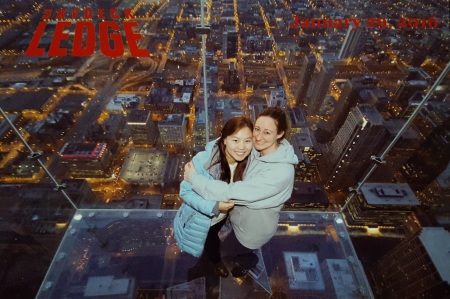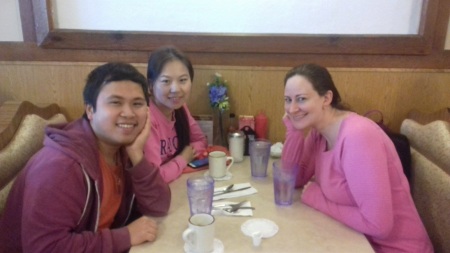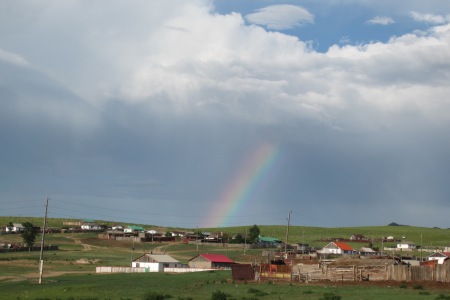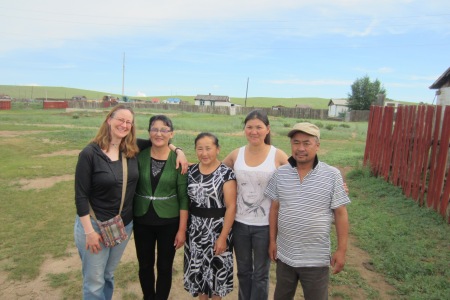Knock on wood; I’ve been a healthy person. It’s not something I’ve taken for granted; many a Thanksgiving my health has topped the list of things for which I am thankful. But, living in a developing country presents new challenges and managing even a run-of-the-mill cold may require more effort here than at home.
The two Peace Corps Medical Officers (PCMOs) in UB are responsible for our well-being. During PST, they give numerous trainings covering general health concerns and those specific to Mongolia. Topics covered include: alcohol (including the alcohol content of different drinks, alcoholism, alcohol as a means of escaping or coping), mental health (including the warning signs of depression and the methods of coping), dog bites, healthy eating (to the extent possible in soums with few vegetables), medications (which to use for which symptoms, what’s available in our individual med kits, what’s available by request from the PCMO), and sexual health issues (including sexual assault, alcohol and sex, Sexually Transmissible Infections and how to prevent them, and exploring the reasons people engage in sexual activity). That’s not an exhaustive list. Outside of trainings, our PCMOs also take care of in-country vaccinations, flu shots and annual physicals. When something goes wrong while we are at site, they make the decision to get us to UB so they can examine us in person. And if something goes really wrong, they make the decision to send us to Thailand for treatment. They are available 24/7 via an emergency number; of course, we are advised to troubleshoot non-emergency issues on our own first.
The Health Manual answers basic questions of symptoms and preliminary treatment and allows us to triage the more serious issues to the PCMOs. My first experience with the Health Manual was shortly after my arrival at site. I had an earache which isn’t something that I’m prone to getting. The earache was mild and short-lived so I never bothered with contacting the PCMOs about it. But I learned from the Health Manual that “for some inexplicable reason, a few Volunteers will develop excessive earwax during their time in Mongolia.” And it was true! For a while I was thinking to myself, “where’s all this ear wax coming from?” But since it wasn’t cause for concern, it wasn’t worth mentioning. I imagine it has something to do with the different climate and altitude and it’s probably further proof that I’ve adapted since over the 22 months here (wow!), my earwax has returned to “normal” levels.
The med-kit contains a medley of over-the-counter meds, a pair of rubber gloves, water-purifying tablets, rehydrating salts, condoms, an ace bandage, gauze, generic band-aids, bug spray, sunscreen, well, here’s a picture.
 If we need a resupply of things, we can request via phone call or email and they’ll mail it to us at site. I’ve gotten PCMO packages in 2 days!
If we need a resupply of things, we can request via phone call or email and they’ll mail it to us at site. I’ve gotten PCMO packages in 2 days!
The PC/Mongolia Cook Book I’ve touched on briefly before. But let me highlight the best thing about it, and where it differs from other cook books I’ve owned. This cookbook has recipes which only use ingredients we can get here. Other recipe books wanted fancy ingredients that I didn’t know where to buy or would only use a portion of before the remainder would spoil. This cook book is divided into two sections, Hungry Hudoo (for the Volunteers living in the countryside with fewer options) and Posh Corps (for the Volunteers in UB and those of us who have more variety). What this means is that I can make any of the Hungry Hudoo recipes and many of the Posh Corps recipes (except for the fact that I don’t cook meat or have an oven). But, armed with this cook book, I’ve learned to make: vegetarian chili, ginger tofu, black bean burgers, lentil burgers, any bean falafel, risotto, curry carrot soup, tomato soup, corn chowder, sweet and sour beets, peanut sauce, hummus, tzatziki, tortillas, no-bake cookies, rice cooker cake, and best of all, rice cooker brownies!!!
My reason for writing on this topic is that over the last 2 weeks I’ve had some experience with the Mongolian hospital in town and realized that I never really posted about our medical care here. So, now that I’ve done that, I’ll recount my experience.
Around the beginning of March I had a cold, nothing serious. The symptoms were a shallow cough, which morphed into a sore throat, before settling into a runny nose accompanied by sneezing a week later. I’m well familiar with Upper Respiratory Infections and back home I’d suffered through far worse symptoms before finally going to my Primary Care doc only to find I’d had walking pneumonia or bronchitis. I wouldn’t say I have a high tolerance for pain or am averse to medical treatment, but just that I procrastinated until I couldn’t any more.
But, with this particular cold, on a Tuesday night after English club, I felt a double earache coming on, the right side worse than the left. And, since I’m less familiar with these than the URIs, I consulted the Health Manual. I learned that earaches after colds could be a middle-ear infection, and that complication included a ruptured eardrum with the possibility of temporary hearing loss. As the pain was getting worse, I started freaking out a little (as much as I can freak out, which, to look at me, maybe you wouldn’t have known). I didn’t call the PCMO emergency number because, I reasoned, there was nothing they could do, or advise me to do, that would help immediately. I decided to call first thing in the morning.
It was a difficult night trying to sleep. The pain was worse when lying down. Sitting up didn’t help much, but it was an improvement. I’d taken Tylenol, which didn’t seem to make a difference, and I was worried about taking too many so I didn’t take any more. It was nearly 3am that I couldn’t stay awake anymore and tried to sleep.
When I awoke, the first thing I noticed was that there was no pain. Well, that wasn’t entirely true, but it was a 1 or 2 vs. a 5 or 6 (on that 1-10 pain scale) so I was relieved. I could tell there was moisture in my ear, and sure enough, a cotton swab (and my pillow) showed a slightly bloody fluid. I assumed a ruptured eardrum, but my hearing, though muffled, was still there. Big sigh of relief!
Long story short, after gathering the information, the PCMO (who, just a few weeks prior, had visited our very hospital) authorized me to visit the Ear, Nose and Throat doctor (which not all hospitals here have). Oyundar, the otolaryngologist, examined my ear, said, in English, “no puncture,” and reported back to an interpreter in UB who relayed the diagnosis to the PCMO. The PCMO then allowed me to be treated by the doc. That first day, when she inserted a 2-inch long strip of gauze, that had been dipped into a solution, into my ear, oh, joy! The remaining pressure I’d felt was relieved. And when I’d removed the strip of gauze 2 hours later, I could hear! It wasn’t permanent, meaning it blocked again when I blew my nose, but it was promising. I noticed that night, while lying in my bed in the absolute silence of night, that there was a bit of high-pitched ringing in my right ear.
Over the last 2 weeks, I have made 8 visits to the hospital. It’s pretty crowded in the lobby, where the registration window is, but I don’t have to register. Registered patients are given laminated, numbered tickets, just like you were at the deli. The ENT’s office is on the second floor, across from a pediatrician’s office, at the end of a corridor. One morning I counted 30 people waiting in the hallway. There are benches to accommodate 8-10 people. I wait alongside them, one day for nearly an hour, but once the doc knows I’ve arrived, she ushers me in and the visits are pretty routine. The door’s two glass panels are covered with opaque film, so waiting patients often poke their heads in to see what’s going on. During the third visit, the otolaryngologist charged me 10,500 tugs (about $6) to cover the total number of visits.
There hasn’t been any ear pain since that first night, and the ringing in the ear is gone (or, at least I can’t hear it anymore). She originally said 5 visits, so for the last 3 visits I’ve been asking, in Mongolian, “tomorrow, I don’t come, right?” But, she kept saying to come. Finally, today she wrote a prescription and we had to get the PCMO on the phone again, along with the translator. Turns out, she wants me to use steroid ear drops for the next three days. The PCMO approved this. She also wanted to give me an aloe injection. The PCMO rejected this. The doc and I were able to communicate using a sort of Mong-lish, and I understood that I am to take 2 drops every 8 hours, and return in 3 days. I took my script to the pharmacy and paid the 7,000 tugs (about $4) and remembered to ask for a receipt, my first time asking in Mongolian, so that Peace Corps can reimburse me.
I’ll be home in ~3 months and I look forward to hearing your voices in person!





 Posted by eelevol
Posted by eelevol 




















